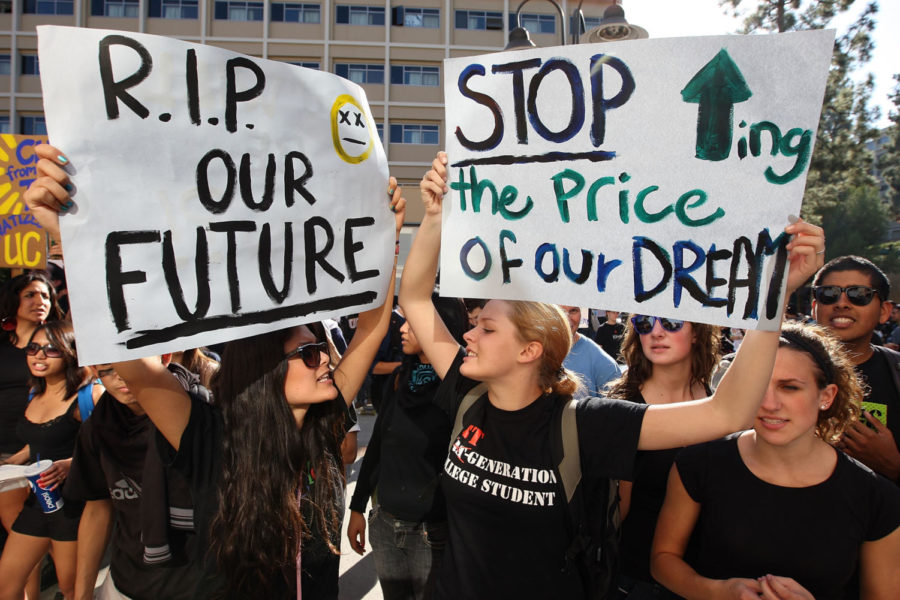An argument against college tuition costs
LOS ANGELES, CA – NOVEMBER 19: University of California Los Angeles (UCLA) students Andrea Flores (L) and Kendall Brown (R) and other UCLA students and supporters demonstrate outside the UC Board of Regents meeting where members voted to approve a 32 percent tuition hike next year on November 19, 2009 in Los Angeles, California. Undergraduate fees for students at the California university system would be increasing by about $2,500. It is the second day that demonstrators, including students from other UC campuses, have gathered to try to dissuade the board from approving the proposed increase. Massive cuts to balance the state budget have squeezed education funds in California. (Photo by David McNew/Getty Images)
Over the past couple of years, the cost of college has been on the rise. Whether it is stopping them from going to a certain college or leaving them in debt, more and more students are starting to feel the stress of high college tuition.
Talks about college decisions used to involve assessing which school provided the most opportunities and which one the student felt most comfortable attending. Now, however, money dominates those conservations.
For many, money is the determining factor and rules over any other factors in the college decision. The least expensive school is where they go. Of course, it is the smart option, they do not want to be in debt for the rest of your life. But sometimes, letting money be the deciding factor takes away a lot of opportunities and can shift the path that they take.
For one sophomore at UConn, who prefers to remain anonymous, the process was a frustrating one. The decision came down to UConn Storrs or Sacred Heart University, where he would be able to play football. Of course, he was very eager to continue his football career, but unfortunately, the cost was too much. Trying to work it out and pay all of that would be very difficult.
“It was very frustrating. At first all I cared about was continuing to play the sport that I devoted so much time to. There was really no other option than Sacred Heart in my eyes. However, I started to open my eyes to the cost and realized that if I wanted to go to med school then I would have to go to UConn,” the student recalled.
In an article about student loan debt by Debt.org revealed, “The average student debt in 2017 was $37,172.”
Yes, money does have to be considered when deciding on college, but it should not be making the impact that it is.
Therefore, some kids are deciding to ignore the money factor; they go to the school that they like the most or feel is the best fit and then deal with the money issues afterward. Unfortunately, the effects are piling up.
As a CNBC headline states, “For some students, what they borrow can end up being a fraction of what they wind up owing.”
Due to interest rates and the amount of time that it takes for the loans to be paid off now, the amount just keeps increasing.
According to CNBC, “Outstanding student loan debt in the U.S. has tripled over the last decade, surpassing auto and credit card debt and only second to housing debt, and now stands at $1.5 trillion.”
And U.S.News recently reported that, “The standard repayment plan for federal student loans put borrowers on a 10-year track to pay off their debt, but research has shown the average bachelor’s degree holder takes 21 years to pay off his or her loans.”
That means students are going to school for 4 years to get a bachelors and once they are done, they are whacked with student debt for 21 years. And then there are the students that continue on to get master’s, doctorates, etc. When they continue to get more degrees, they are extending the amount of time that it will take them to be debt free.
Several government officials are trying to ease the stress for students. The Trump Administration is urging Congress to reauthorize the Higher Education Act. The piece of the act that is being focused on is the borrowing aspect.
Currently, the amount that a student can borrow over their lifetime is $57,500. But there are no limits placed for the parents. The administration is looking into lowering the cap amount as well as adjusting the PLUS loan program, the program that allows parents to take out loans to help pay for their child’s schooling.
According to CNN, “Some research suggests that unlimited borrowing may encourage colleges to drive up the price of tuition.”
Last year, Representative Virginia Foxx proposed cutting the student borrowing amount to $28,500 and parent borrowing to $12,500 annually but it did not go through. However, with more officials focusing in on this issue, Congress is hoping to make some progress in easing the debt issues.
Senator Lamar Alexander told CNN, “I share the administration’s goals to make college worth it and to make it simpler to apply for federal student aid and pay back student loans.”
Alexander hopes to get the ball rolling and have something passed by 2020, which is when he will retire.
Many officials are realizing this problem and starting to make it a priority to fix. Complete loan forgiveness would a be virtually impossible, but lowering costs and amount of debt is not.
“Concerned is not even the word. I am nervous for the impact that the rising cost of college will have on my future,” said Shannon Burns, a senior at Naugatuck High School.

I am a senior, and I will be attending college to pursue a career in elementary education. I took Journalism to improve my writing and to become more involved...








